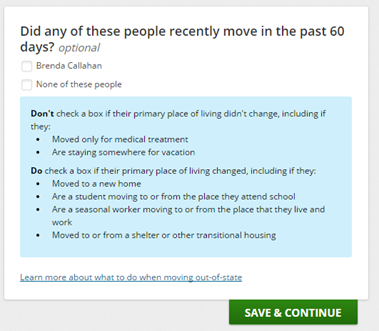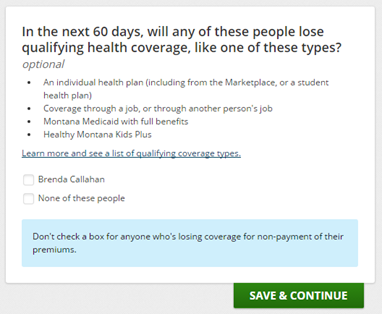Fact Sheet: Special Enrollment Confirmation Process
Special enrollment periods (SEPs) are an important way to make sure that people who lose health insurance during the year or who experience major life changes like getting married or having a child have the opportunity to enroll in coverage through the Health Insurance Marketplaces outside of the annual Open Enrollment period. SEPs are a longstanding feature of employer insurance, and without them many people would lack options to maintain continuous coverage. But itâs equally important to avoid SEPs being misused or abused.
At CMS, we are always monitoring the health and operations of the Marketplace and looking for ways to improve. We are focused on continually maintaining and refining a set of Marketplace rules that create a healthy, stable and balanced risk pool. Concerns have been recently raised about whether current Marketplace rules and procedures are sufficient to ensure that only those who are eligible enroll through SEPs. In response to that feedback, today we are announcing a new Special Enrollment Confirmation Process that will address these concerns in the 38 states using the HealthCare.gov platform. These changes will enhance program integrity and contribute to a stable rate environment and affordability for consumers.
Once the new Special Enrollment Confirmation Process is implemented, all consumers enrolling through the most common HealthCare.gov SEPs will need to submit documentation to verify their eligibility to use an SEP. The Special Enrollment Confirmation Process will be accompanied by other improvements to the SEP application process, described below. Todayâs announcement represents a major overhaul of the SEP process.
Over the next few weeks, CMS will invite comment from consumer advocates, insurance companies and other stakeholders on the key features of the new Special Enrollment Confirmation Process, such as communication with consumers, acceptable documentation, and refining and targeting the verification process. These comments will help inform implementation of the new process. Â This announcement builds on action CMS has taken to eliminate unnecessary SEPs and clarify the rules for other SEPs.
HOW SPECIAL ENROLLMENT CONFIRMATION WORKS
Document Submission by Consumers: Beginning in the next several months, all consumers who enroll or change plans using an SEP for any of the following triggering events will be directed to provide documentation:
- Loss of minimum essential coverage,
- Permanent move,
- Birth,
- Adoption, placement for adoption, placement for foster care or child support or other court order, or
- Marriage. Â
These SEPs represented three quarters of HealthCare.gov consumers who enrolled or changed plans using an SEP in the second half of 2015.Â
We will provide consumers with lists of qualifying documents, like a birth or marriage certificate. Consumers will be able to upload documents to their HealthCare.gov account or mail them in.
Document Verification by CMS: CMS will institute a verification process for consumers who enroll or change plans using an SEP in 2016. The Special Enrollment Confirmation Process is modeled after approaches used by the Internal Revenue Service. We will review documents to ensure consumers qualify for an SEP and will follow up with consumers if there is a question or problem. Consumers need to be sure to provide sufficient documentation. If they donât respond to our notices, they could be found ineligible for their SEP and could lose their insurance.
IMPLEMENTING THE SPECIAL ENROLLMENT CONFIRMATION PROCESS
As we move forward with implementing the Special Enrollment Confirmation Process, CMS intends to work closely with our enrollment partners. In particular, we invite feedback on:
- Communicating with consumers about providing required documents: As CMS implements the Special Enrollment Confirmation Process, we will work closely with enrollment partners to ensure our notice language is clear about what documents a consumer should submit and how those documents can be submitted. We also invite feedback on best practices for communicating with consumers regarding what documents can be used to establish eligibility for different SEPs.
- Refining the confirmation process: We invite feedback on how our verification efforts respond to areas where there is the greatest risk of SEP misuse.
- Training assisters, agents and brokers: CMS will develop resource guides for advocates, assisters, agents and brokers to help them understand the Confirmation Process, acceptable documents, and situations in which consumers do and donât qualify for SEPs.
Feedback on the Special Enrollment Confirmation Process should be sent to SEP@cms.hhs.gov.
WHAT ELSE CMS IS DOING TO IMPROVE PROGRAM INTEGRITY FOR SPECIAL ENROLLMENT PERIODS
Requiring consumers to acknowledge document request and reminding consumers of the need to be truthful: In the next few weeks, HealthCare.gov will require all consumers who enroll or change plans through an SEP to indicate they understand that documents will be requested to verify their SEP eligibility. This process will begin in the coming weeks and will ramp up over time and continue expanding once the Special Enrollment Confirmation Process is fully in place. Consumers must also attest at the end of their HealthCare.gov application that they are providing true information and understand the penalties for misrepresentation. Weâll be updating the application to include additional attestation language so that consumers understand that they are required to be truthful and risk losing their eligibility for Marketplace coverage.
Clarifying application questions for consumers: In the coming weeks, weâll be updating HealthCare.gov to make it clearer for consumers who are submitting or updating an application to understand what does and doesnât qualify as a loss of minimum essential coverage, and a permanent move. Here are a couple of examples:
   Â
Call 1-800-318-2596 to report Fraud or abuse: Anyone who suspects that there has been fraud or abuse in the Marketplace should call 1-800-318-2596 to report their concerns. Simply indicate that you are calling about fraud and abuse and CMS investigators will receive the complaint. Â
###


